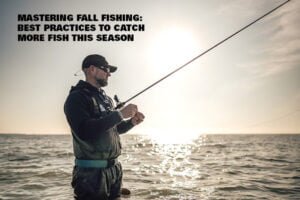
Fall fishing begins as the leaves begin to change, the air turns crisp, where anglers know that fall is one of the best seasons for fishing.
Fish species in both inshore and freshwater environments become more active and aggressive in their feeding patterns, making it an ideal time to get out on the water.
To maximize your success during the fall season, it’s essential to employ the right techniques and strategies.
Below we will review some of the best practices for catching more fish during the autumn months.
1. Understand Seasonal Changes
Before you hit the water, it’s crucial to understand how the fall season affects fish behavior.
As the water temperature drops, fish become more active and begin to feed voraciously, preparing for the winter ahead.
This increased activity means more opportunities for anglers to catch fish.
However, fish also tend to move to different areas and change their feeding habits, so adaptability is key.
2. Choose the Right Baits and Lures
Fish are actively foraging in the fall, so it’s essential to offer them the right bait.
In freshwater, try using crankbaits, soft plastic worms, and jerkbaits. Live or cut bait can be highly effective for saltwater inshore environments.
Experiment with various colors and sizes to see what the fish are responding to on that particular day and always pay attention to what your local fish are keyed in on and replicate that forage as best you can.
3. Locate Prime Fishing Spots
In the fall, fish tend to migrate to specific areas in search of food and comfortable water temperatures.
In freshwater, look for areas with structure, such as fallen trees, rocks, or underwater vegetation.
For inshore fishing, focus on spots with good water flow, like estuaries, creek mouths, and oyster beds.
These areas provide an abundance of food as well as create a safe environment from the structure, making them prime fishing grounds during the fall.
4. Pay Attention to the Weather
Weather conditions play a significant role in fall fishing success.
Overcast days and light rain can stimulate fish to feed more aggressively, while cold fronts may temporarily slow down their activity.
Monitoring weather forecasts and planning your fishing trips accordingly can make a substantial difference in your catch rate.
5. Time Your Outings
Fall fishing often rewards early birds and those willing to fish during the late afternoon.
Just like most animals, fish tend to be more active around sunrise and sunset.
Keep an eye on tide charts for inshore fishing and try to time your outings around moving water as this can improve your chances of a successful catch.
Conclusion
The fall season offers fantastic fishing opportunities, no matter where it is you fish.
By understanding some of these seasonal changes and adjusting accordingly, you can significantly increase your catch rate.
Remember that every day on the water is a learning experience, so adaptability and patience are essential virtues for every angler.
With these best practices in mind, you’ll be well-equipped to make the most of the autumn fishing season and reel in memorable catches.
And as always, if it doesn’t work…you can blame me.
Written by Reid Miller: 13 Fishing Marketing Coordinator

